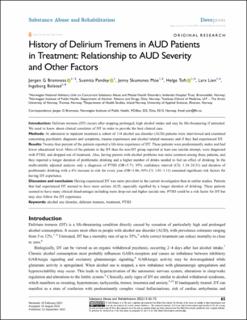| dc.contributor.author | Bramness, Jørgen Gustav | |
| dc.contributor.author | Pandey, Susmita | |
| dc.contributor.author | Moe, Jenny Skumsnes | |
| dc.contributor.author | Toft, Helge Prytz | |
| dc.contributor.author | Lien, Lars | |
| dc.contributor.author | Bolstad, Ingeborg | |
| dc.date.accessioned | 2022-11-15T08:18:47Z | |
| dc.date.available | 2022-11-15T08:18:47Z | |
| dc.date.created | 2022-11-02T09:16:32Z | |
| dc.date.issued | 2022 | |
| dc.identifier.issn | 1176-6328 | |
| dc.identifier.uri | https://hdl.handle.net/11250/3031798 | |
| dc.description.abstract | Delirium tremens (DT) occurs after stopping prolonged, high alcohol intake and may be life-threatening if untreated. We need to know about clinical correlates of DT to provide the best clinical care. At admission to inpatient treatment a cohort of 114 alcohol use disorder (AUD) patients were interviewed and examined concerning psychiatric diagnosis and symptoms, trauma experiences and alcohol related measures and if they had experienced DT. Results: Twenty-four percent of the patients reported a life-time experience of DT. These patients were predominantly males and had lower educational level. More of the patients in the DT than the non-DT group reported at least one suicide attempt, were diagnosed with PTSD, and dropped out of treatment. Also, having parents with alcohol problems was more common among these patients, and they reported a longer duration of problematic drinking and a higher number of drinks needed to feel an effect of drinking. In the multivariable adjusted analysis only a diagnosis of PTSD (OR=5.71; 95% confidence interval (CI): 1.34–24.31) and duration of problematic drinking with a 6% increase in risk for every year (OR=1.06; 95% CI: 1.01–1.11) remained significant risk factors for having DT experience. Having experienced DT was more prevalent in the current investigation than in earlier studies. Patients that had experienced DT seemed to have more serious AUD, especially signified by a longer duration of drinking. These patients seemed to have many clinical disadvantages including more drop-out and higher suicide rate. PTSD could be a risk factor for DT but may also follow the DT experience. | en_US |
| dc.language.iso | eng | en_US |
| dc.rights | Navngivelse-Ikkekommersiell 4.0 Internasjonal | * |
| dc.rights.uri | http://creativecommons.org/licenses/by-nc/4.0/deed.no | * |
| dc.subject | alcohol use disorder | en_US |
| dc.subject | delirium tremens | en_US |
| dc.subject | treatment | en_US |
| dc.subject | PTSD | en_US |
| dc.title | History of Delirium Tremens in AUD Patients in Treatment: Relationship to AUD Severity and Other Factors | en_US |
| dc.type | Peer reviewed | en_US |
| dc.type | Journal article | en_US |
| dc.description.version | publishedVersion | en_US |
| dc.subject.nsi | VDP::Medisinske Fag: 700 | en_US |
| dc.source.pagenumber | 65-72 | en_US |
| dc.source.volume | 13 | en_US |
| dc.source.journal | Neuropsychiatric Disease and Treatment | en_US |
| dc.identifier.doi | 10.2147/SAR.S361810 | |
| dc.identifier.cristin | 2067719 | |
| dc.relation.project | Norges forskningsråd: 251140 | en_US |
| cristin.ispublished | true | |
| cristin.fulltext | original | |
| cristin.qualitycode | 1 | |

